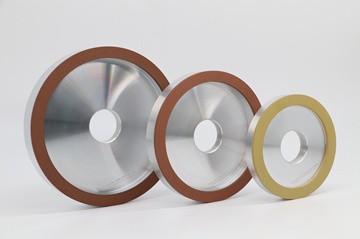Do and Don’t for Safe Grinding

Do and Don’t for Safe Grinding
Grinding wheels are safe tools when they are used in accordance with some basic rules.
However if they are used incorrectly or not installed carefully onto the machine, there is the possibility that the grinding wheel may fracture.
Be sure to observe the “Do” and “Don’t” for safe work.
The following basic rules are based on the Ordinance on Industrial Safety and Health and on Structural Standard for grinders and Related Equipment.
Do
1 Handle and store wheels in a careful manner.
Observe the 3 basic rules of “no rolling, no dropping, and no contact with other objects”.
Store wheels on a shelf or storage rack in a dry place.
2 If the grinding wheel is marked with a service limit, be sure to use it only within the service limit period.
3 Before mounting a wheel onto a machine, perform a visual inspection and ring test (hammering test) to check for cracks, chips, and other problems.
4 Check that the maximum operating speed, dimensions, and other specifications of the grinding wheel are correct for the machine where it will be used.
5 Check that the outer diameters and contact widths of the mounting flanges are equal and correct on the left and right sides.
6 Use the blotters that are supplied with the wheels.
The blotters should be larger than the flange diameter and must not be stained or torn.
7 Balance the wheel with balancing weights.
8 Be sure that the work rest is properly adjusted. The wheel should be no more than 3 mm away from the work rest and 3 – 10 mm away from the adjustment piece.
9 The standard length of the wheel spindle after mounting should be 13 mm.
10 Use a grinding wheel cover which covers at least one half of the grinding wheel at all times.
11 Perform test operation for at least 1 minute before the first grinding of the day, and for at least 3 minutes before using a newly mounted wheel.
For a portable grinder, be sure to perform the test operation in a safe place.
12 Wear safety goggles, dust-proof mask, and other necessary protective gear during operation.
13 In order to avoid disrupting the balance, completely shut off the coolant before stopping the wheel rotation.
14 Use shield plates or other means to protect operators from sparks.
15 In order to prevent respiratory illnesses, be sure to ensure dust control and sufficient ventilation.
Don’t
1 Do not use a grinding wheel that was dropped or subjected to other impact, or a grinding wheel where any abnormality was found during inspection.
2 If the hole diameter of the grinding wheel does not match the machine, do not force the wheel onto the machine or alter its hole diameter.
3 Do not exceed the maximum operating speed that is marked on the wheel.
4 Do not use mounting flanges if the surfaces which contact the grinding wheel are deformed, scratched, dirty, or corroded.
Do not use flanges that do not have roll-offs. If the wheel is attached by nuts, do not use flanges (base plates) that have roll-offs.
5 When mounting onto the flanges, do not over-tighten the nuts.
6 Do not use the side of the wheel unless the wheel is specifically designed for that purpose.
7 Do not start the machine before the grinding wheel cover is installed.
8 Do not use excessive force to press the workpiece against the grinding wheel, or the grinding wheel against the workpiece.
9 Do not directly touch a rotating grinding wheel with any part of your body.
10 During test operation, do not stand in front of the grinding wheel direction of rotation.
11 When working with a portable grinder, do not place the grinder onto a table, floor, workpiece, or other surface before the grinding wheel has fully stopped.
12 Do not perform grinding in a location where there is the risk of ignition or explosion.
13 Do not enter the area where sparks are produced.
14 Do not change grinding wheels or perform test operation unless you have completed all necessary education and training.
